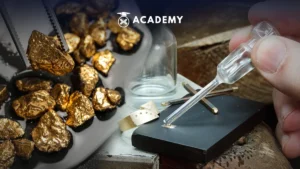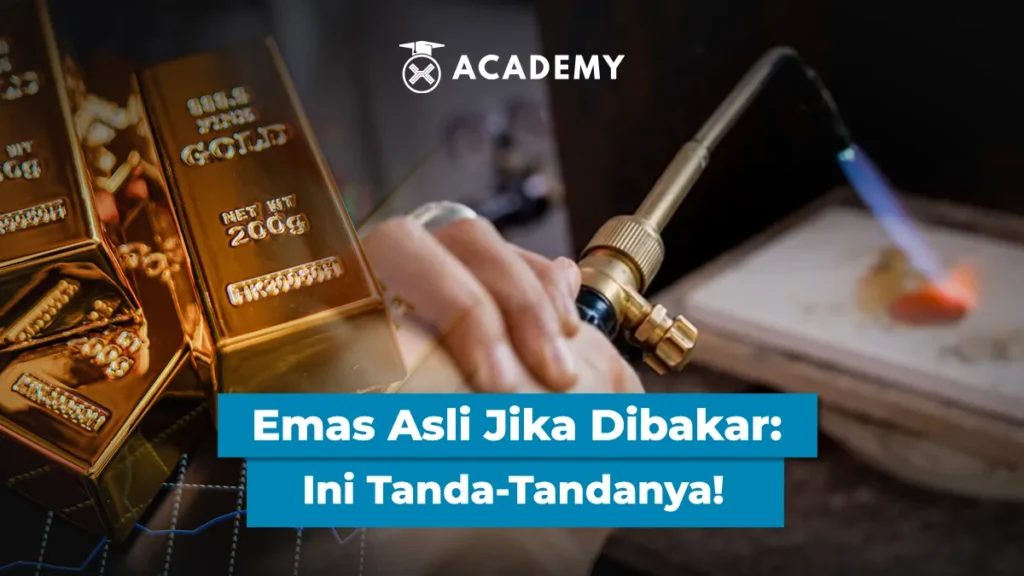Have you ever heard that real gold will not be damaged or melted when burned? Many people are curious about this assumption, is it true that fire can be an easy way to distinguish real gold from fake?
In the midst of the booming gold buying and selling, it is important to know a simple but effective way to test its authenticity, especially if you want to make sure your valuables are truly valuable.
In this article, we will discuss the scientific facts behind gold’s reaction to heat, provide practical tips, and explain the safest and most accurate way to conduct a fire test without damaging your items.
You may also be interested in this: Authenticity Test, Here are 10 Ways to Manually Distinguish Real and Fake Gold
Why Can Burning Be Used to Test Gold?

Using fire to test gold may sound extreme, but there is actually a scientific reason behind this method. Precious metals like gold have unique physical characteristics and chemical reactions when exposed to heat.
Let’s go into more detail to understand why burning can be one of the simple ways to detect the authenticity of gold.
1. Physical Characteristics of Real Gold
Real gold is known to be heat resistant and not easily damaged when burned. This is because gold is a precious metal that is durable and does not react with oxygen in the air so it is not affected by oxidation or corrosion.
In addition, real gold usually has certain marks or stamps on its surface, especially on gold bars, which indicate its purity level.
This metal is also relatively soft and easy to shape, especially if the content is high. That is why real gold can sometimes be recognized by biting it, if it leaves a bite mark then it is likely pure gold.
However, be careful because tin is also soft and can be deceiving, so it is still advisable to check in other ways.
Color can also be a clue, namely pink gold (rose gold) which is currently popular among women, is a combination of gold with other metals, but still shows the physical characteristics of real gold.
2. Reaction of Real Gold when Burned
When burned, real gold will retain its shine and will not change color to black. This is because gold does not react easily with ordinary fire such as from matches or candles.
Unlike fake metals that can turn black due to burning or oxidation, gold remains stable and undamaged.
3. Facts about the Melting Point of Gold
One of the reasons why fire can be used to test gold is because its melting point is very high, which is around 1,064°C.
The fire from a regular lighter or candle is not hot enough to melt gold, so if the metal melts or changes shape when burned with a regular flame, it is most likely not pure gold.
That is the scientific basis for the burning method as a simple test to identify real gold.
Another interesting article for you: 6 Ways to Save Gold at Home 2025: Safe and Practical Tips!
What Happens to Real Gold When Burned?
Many people are curious, what exactly will happen if gold is burned? Is it true that real gold will remain intact, or can it change?
Although this method is not the most recommended, observing the gold’s reaction to heat can provide interesting clues about its authenticity. Here is an explanation of what usually happens to real gold when burned.
1. Does Not Change Color
Pure gold or 24 karat gold can indeed show a color change when burned, usually turning black due to the heat reaction that produces an oxide layer on the surface.
However, don’t worry, this black color is not a sign of permanent damage and can be cleaned. Meanwhile, fake gold or other metal alloys may change color in different ways, depending on the type of metal in it.
Therefore, the color reaction when burned can be one of the initial ways to distinguish real and fake gold.
2. No Burning Metal Smell
Another characteristic that can be observed is the aroma that appears when burned. Real gold does not emit a burning metal smell, because it does not contain elements that evaporate and have a sharp smell.
On the other hand, if you smell a strong metallic odor, then it is likely that the metal is not pure gold. This odor usually comes from alloys such as copper or other materials that are easily oxidized when exposed to heat.
Another interesting article for you: Today’s Gold vs Bitcoin Price: Which is More Profitable?
Risks and Advantages of Testing Gold with Fire
Using fire to test gold does seem simple and fast. However, this method still has advantages and disadvantages that you need to consider before trying it yourself. Here is a complete explanation:
1. Advantages of the Burning Method
One of the main advantages of the burning method is its simplicity. You don’t need to use sophisticated laboratory equipment, even a match or candle is enough to do an initial test on gold.
This makes this method feel practical and accessible, especially for those of you who want to ensure the authenticity of jewelry in a simple way at home.
The reaction shown by gold when burned, such as not changing color permanently or not smelling burning metal, can provide an initial picture of the authenticity of the metal.
2. Risks of Testing with Fire
Although it looks easy, burning gold still has risks. One of the risks is physical damage to fake gold that is only coated with a thin layer of gold on the surface.
The coating can peel or melt due to hot temperatures, which of course will reduce the aesthetic value and even its selling value.
In addition, there are also safety risks. Using fire without proper protection or in an unsafe place can cause injuries, such as burns or dangerous sparks.
Therefore, if you still want to try this method, it should be done very carefully and not make it the only way to check the authenticity of gold.
Another interesting article for you: Get to Know 5 Types of Gold Bars in Indonesia for Investment
Safe Tips for Testing Gold by Burning
Testing the authenticity of gold with fire can indeed be done independently, but you still need to be careful so as not to pose a risk to yourself or the jewelry being tested.
Here are some tips that you can follow to make the process safer and more effective.
1. Use a Small Flame and Tongs
Before starting, make sure you use a stable fire source, such as a butane lighter, not a large flame from a stove or torch. This aims to maintain control during the burning process.
In addition, use heat-resistant metal tongs or pliers to hold the gold. This is important so that your hands remain safe from high temperatures and sparks.
Basically, using tongs will also make the observation process more stable and accurate.
2. Burn a Small Part Only
There is no need to burn the entire surface of the gold. Just focus the fire on a small part, such as the corner of the jewelry or the back side.
This will minimize the risk of damage to the shape or appearance of the gold, especially if it turns out that the jewelry is not pure.
The firing process can be done for about 60 seconds to get enough temperature to cause a reaction in the metal.
3. Observe the Reaction in Detail
When the gold is fired, observe carefully what happens to its surface. The color that changes to black, although generally temporary, can be a sign that the gold is genuine.
In addition, pay attention to whether there is a change in shape. Pure gold will usually soften when heated, while other metals or gold alloys may not react similarly.
After the process is complete, let the gold cool naturally and observe the results to avoid wrong conclusions.
Characteristics of Fake Gold When Burned
Burning gold can be one way to distinguish between real and fake gold.
The reactions that occur during this process can be important clues, especially if you understand how pure metals and alloys behave when exposed to high heat.
The following are signs of fake gold that you need to know and be aware of when burning.
1. Fake Metal Will Blacken
When burned, real gold, especially those with a content of 99.99% or 24 carats, will indeed turn black due to the formation of an oxide layer on its surface.
However, this black color is temporary and can disappear after being cleaned. In contrast, fake gold usually shows a more striking and uneven color change.
This happens because alloys such as copper or silver oxidize in a different way, producing black spots or even greenish colors that cannot be removed easily.
It is important to understand that this oxidation reaction is an early indicator that the metal is not pure gold.
2. Fake Metal Melts Easily
Pure gold has a relatively high melting point, but will still soften when exposed to high heat.
If the gold has a content of 99.99%, its shape can change when burned because of the nature of precious metals that are easy to forge after being heated.
However, fake metals or mixed gold tend to have a much lower melting point. When burned, fake metals can immediately melt or partially melt because they are unable to withstand high temperatures.
This reaction is different from real gold which only softens without melting drastically. Therefore, metal that melts immediately when tested with fire is certainly not pure gold.
Another interesting article for you: Types of Gold for Investment: Which is the Most Profitable?
Alternative Ways to Distinguish Real Gold without Burning

While burning gold can cause certain reactions, there are many safer and less damaging ways to distinguish real gold from fake gold.
Some of these methods are easy to do at home and can give fairly accurate results if done correctly. Here are some ways you can try:
1. Use a Magnet
To distinguish real gold in a practical way, you can use a magnet. Real gold is not magnetic so it will not be attracted or stick to a magnet.
You only need to bring the magnet close to the jewelry you want to test. If the jewelry sticks or moves closer to the magnet, it is certain that it is not pure gold.
Usually, parts such as jewelry hooks that are not made of pure gold may be slightly attracted to the magnet, so pay close attention to the part being tested.
2. Nitric Acid Test
Another method for testing the authenticity of gold is to use a nitric acid solution.
Real gold will not react when exposed to this acid, while fake metal will usually experience chemical reactions such as color changes or the appearance of small bubbles.
In addition, there is another alternative way without having to use strong acids, such as using vinegar. You simply drip a little vinegar on the gold jewelry.
If there is a color change, it means that the gold is not pure. Conversely, if there is no change and the gold remains shiny, then it is likely real gold.
3. Professional Inspection at a Gold Shop
The most accurate step to ensure the authenticity of gold is to take it to a trusted gold shop for a professional inspection.
Gold experts can perform a series of physical and chemical tests with more accurate tools.
In addition, you can also consult on how to maintain the authenticity of gold and get information about trusted places to buy gold.
Also, always pay attention to the gold certificates and labels provided, and buy gold at licensed gold shops, such as Butik Emas Antam or Pegadaian. to guarantee the authenticity and value of your gold investment.
Start Investing in Digital Gold and Bitcoin at Indodax
After understanding the importance of real gold when burned and its signs to crypto assets, the next step is to choose the right platform to start your investment.
Digital gold such as Pax Gold (PAXG) and Bitcoin are now easier to access through trusted exchange crypto
At Indodax, you can buy digital gold and buy Bitcoin with a safe, fast, and verified process. That way, you can build a more balanced asset portfolio between gold stability and crypto growth potential.
Check the latest digital gold and Bitcoin prices on Indodax now, and start your investment journey with more confidence.
Conclusion
Well, that was an interesting discussion about Real Gold if Burned which you can read in full at the Crypto Academy at INDODAX Academy.
In conclusion, testing the authenticity of gold by burning it can indeed be one method, but it must be done very carefully so as not to damage the jewelry.
Real gold will generally remain shiny and will not experience permanent color changes after being burned. However, this method is not always recommended, especially for high-value jewelry.
For safer and more accurate results, it is recommended to use other alternatives such as magnet tests, acid tests, or conducting direct checks at trusted gold shops.
Thus, you can ensure the authenticity of the gold without taking unnecessary risks.
FAQ
1.What happens if real gold is burned?
Real gold remains shiny and does not change color.
2.Can real gold melt with a lighter?
No, because gold needs a temperature of more than 1,000°C to melt.
3.Why does fake gold turn black when burned?
Because fake metal is easily oxidized when exposed to heat.
4.Is burning gold safe for all types of gold?
No, especially for gold plating or other metal alloys.
5.What are other ways to distinguish real gold without burning it?
You can use a magnet test, nitric acid, or check with a professional gold shop.
Author: Boy





 Polkadot 8.91%
Polkadot 8.91%
 BNB 0.54%
BNB 0.54%
 Solana 4.81%
Solana 4.81%
 Ethereum 2.37%
Ethereum 2.37%
 Cardano 1.35%
Cardano 1.35%
 Polygon Ecosystem Token 2.11%
Polygon Ecosystem Token 2.11%
 Tron 2.85%
Tron 2.85%
 Market
Market


